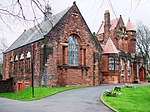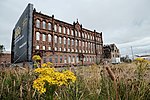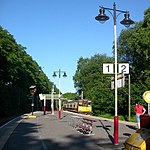Glasgow Shields Road TMD
Rail transport in ScotlandRailway depots in ScotlandTransport in GlasgowUse British English from January 2018

Glasgow Shields Road ETD is a railway electric traction depot in Glasgow, Scotland. The depot is located on the south side of the Glasgow Central to Paisley lines, adjacent to Shields Junction and close to the site of the former Shields Road station. The depot's code is 'GW'.
Excerpt from the Wikipedia article Glasgow Shields Road TMD (License: CC BY-SA 3.0, Authors, Images).Glasgow Shields Road TMD
Altenburger Straße, Leipzig Südvorstadt (Süd)
Geographical coordinates (GPS) Address Nearby Places Show on map
Geographical coordinates (GPS)
| Latitude | Longitude |
|---|---|
| N 55.8469 ° | E -4.2873 ° |
Address
Altenburger Straße
Altenburger Straße
04275 Leipzig, Südvorstadt (Süd)
Sachsen, Deutschland
Open on Google Maps










